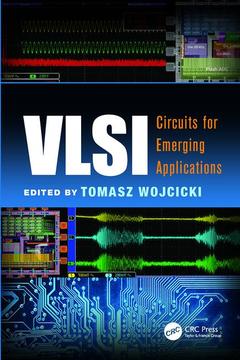VLSI Circuits for Emerging Applications Devices, Circuits, and Systems Series
Coordonnateur : Wojcicki Tomasz

Recently the world celebrated the 60th anniversary of the invention of the first transistor. The first integrated circuit (IC) was built a decade later, with the first microprocessor designed in the early 1970s. Today, ICs are a part of nearly every aspect of our daily lives. They help us live longer and more comfortably, and do more, faster. All this is possible because of the relentless search for new materials, circuit designs, and ideas happening on a daily basis at industrial and academic institutions around the globe.
Showcasing the latest advances in very-large-scale integrated (VLSI) circuits, VLSI: Circuits for Emerging Applications provides a balanced view of industrial and academic developments beyond silicon and complementary metal?oxide?semiconductor (CMOS) technology. From quantum-dot cellular automata (QCA) to chips for cochlear implants, this must-have resource:
- Investigates the trend of combining multiple cores in a single chip to boost performance of the overall system
- Describes a novel approach to enable physically unclonable functions (PUFs) using intrinsic features of a VLSI chip
- Examines the VLSI implementations of major symmetric and asymmetric key cryptographic algorithms, hash functions, and digital signatures
- Discusses nonvolatile memories such as resistive random-access memory (Re-RAM), magneto-resistive RAM (MRAM), and floating-body RAM (FB-RAM)
- Explores organic transistors, soft errors, photonics, nanoelectromechanical (NEM) relays, reversible computation, bioinformatics, asynchronous logic, and more
VLSI: Circuits for Emerging Applications presents cutting-edge research, design architectures, materials, and uses for VLSI circuits, offering valuable insight into the current state of the art of micro- and nanoelectronics.
Integration of Graphics Processing Cores with Microprocessors. Arithmetic Implemented with Semiconductor Quantum-Dot Cellular Automata. Novel Capacitor-Less A2RAM Memory Cells for Beyond 22-nm Nodes. Four-State Hybrid Spintronics–Straintronics: Extremely Low-Power Information Processing with Multiferroic Nanomagnets Possessing Biaxial Anisotropy. Improvement and Applications of Large-Area Flexible Electronics with Organic Transistors. Soft-Error Mitigation Approaches for High-Performance Processor Memories. Design Space Exploration of Wavelength-Routed Optical Networks-on-Chip Topologies for 3D Stacked Multi- and Many-Core Processors. Quest for Energy Efficiency in Digital Signal Processing: Architectures, Algorithms, and Systems. Nanoelectromechanical Relays: An Energy Efficient Alternative in Logic Design. High-Performance and Customizable Bioinformatic and Biomedical Very-Large-Scale-Integration Architectures. Basics, Applications, and Design of Reversible Circuits. Three-Dimensional Spintronics. Soft-Error-Aware Power Optimization Using Dynamic Threshold. Future of Asynchronous Logic. Memristor-CMOS-Hybrid Synaptic Devices Exhibiting Spike-Timing-Dependent Plasticity. Very-Large-Scale Integration Implementations of Cryptographic Algorithms. Dynamic Intrinsic Chip ID for Hardware Security. Ultra-Low-Power Audio Communication System for Full Implantable Cochlear Implant Application. Heterogeneous Memory Design. Soft Error Resilient Circuit Design.
Tomasz Wojcicki is currently vice president of engineering and customer engineering support at Sidense Corporation, Ottawa, Ontario, Canada. He previously worked at the Institute of Electron Technology, Warsaw, Poland, and at MOSAID Technologies, Inc., Ottawa, Ontario, Canada (now Conversant Intellectual Property Management). At MOSAID, he was instrumental in growing the company’s design services into a multimillion-dollar business, and served as a director responsible for the development of a family of classification products based on dynamic and static content-addressable memories. He holds an MSEE from Warsaw Technical University, Poland, as well as six patents, and has authored and coauthored several publications.
Date de parution : 04-2017
15.6x23.4 cm
Date de parution : 10-2014
Ouvrage de 486 p.
15.6x23.4 cm
Thème de VLSI :
Mots-clés :
Power Consumption; Soft Error; Nanoelectronics; Dipole Interaction; Microelectronics; Access Transistor; Bioelectronics; Energy Efficiency; RAM; Solid State Circuits; Random-Access Memory; IEEE Transaction; Nonvolatile Memories; L2 Cache; ICs; IEEE Trans; Integrated Circuits; Cpu Core; VLSI Applications; Static Noise Margin; VLSI Implementations; Low Power Design; VLSI Design; NMOS Transistor; VLSI Chips; Dipolar Coupling; VLSI Circuits; Particle Strike; Very-Large-Scale Integrated Circuits; IOP Publishing; PZT Layer; GPU Core; Array Multiplier; SRAM Cell; Organic Transistors; Reversible Circuits; Asynchronous Circuits; Toffoli Gate; Soft Delay



